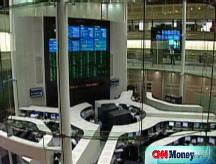Credit freeze sees small cracks
The overnight lending rate fell by half, indicating some short-term relief, but the 3-month interbank rate surged.
NEW YORK (CNNMoney.com) -- Seized-up credit markets began to see the first small signs of easing Friday, but anxiety over the long-term prospects for recovery is keeping lenders mostly sidelined.
The overnight interbank lending rate, known as Libor, fell by half, suggesting that banks are becoming more willing to lend to each other in the very near term. The longer-term 3-month rate, however, continued to rise, hitting its highest level this year.
When banks show a willingness to lend to each other, it makes it easier for consumers and business to obtain loans. The financial crisis that caused Wall Street to buckle has spread around the globe, pushing panicky investors to sell stocks and sit on their capital.
"There is still an awful lot of fear driving this market and a preference to hoard cash rather than lend it out because you don't know if you will get it back," said Kim Rupert, fixed income analyst at Action Economics.
Despite a slew of unprecedented efforts by the Federal Reserve and the government aimed at soothing investor panic, including a coordinated rate cut, passage of a massive $700 billion bailout and other measures, recovery will take time.
"It is going to take several quarters of improvement before we can start to feel comfortable," said John Atkins, fixed income analyst at IDEA Global. "But the corporate defaults are going to start to pile up in the meantime."
Libor rates: The overnight Libor fell to 2.47% Friday, down from 5.09% Thursday, according to data from Bloomberg.com. The rate has been at or near record levels over the past week as banks remain stubborn about lending to each other.
The rate sat at 2.15% just one month ago. Since then, it has been very volatile, spiking to a record 6.88% after the $700 billion bailout passed.
Libor is a daily average of what 16 different banks charge other banks to lend money in London and is used to calculate adjustable rate mortgages. The higher the rate, the tougher it could be for homeowners to pay those mortgages. Libor is also used to calculate other types of loans, including student and auto.
Furthermore, the sharp drop in the overnight Libor could be partly attributed to recent developments in the banking sector. On Wednesday, the British government said it would make $87 billion available to the nation's eight largest banks in an effort to shore-up their capital positions.
Also Wednesday, the United States government said it was considering whether to make direct capital investments in U.S. banks.
However, the 3-month Libor continued to climb ever higher, reaching 4.82% Friday, the highest since mid-December 2007, according to data from Bloomberg.com. The forward-looking rate was 4.75% Thursday, and has been increasing consistently since Sept. 15, when it was only 2.82%.
Market gauges. Other indicators also continued to point to tighter lending. The TED spread reached a record high of 4.65% before retreating slightly to 4.64%.
The TED spread measures the difference between the 3-month Libor and the 3-month Treasury bill, and is a key indicator of risk. The higher the spread, the bigger the aversion to risk. The spread was 1.04% just a little more than a month earlier.
Another indicator, the Libor-OIS spread, also jumped to a fresh record 3.67%, soaring past the 3.47% record high set Thursday. The Libor-OIS spread measures how much cash is available for lending between banks, and is used by banks to determine lending rates. The bigger the spread, the less cash is available for lending.
Treasurys. And in another sign that investors were still panicky, the yield on the 3-month Treasury bill dipped as low as 0.11% before recovering to 0.24%. That's still down from 0.58% late Thursday but getting closer to the unnerved 0% seen Sept. 17 after the government's emergency rescue of American International Group (AIG, Fortune 500) heightened fears about the depth of the crisis. Government bonds are considered a safe haven for investors to park their cash during times of economic uncertainty.
Investors and money-market funds move assets into and out of the 3-month Treasury bill frequently, as they assess risk in the rest of the marketplace. Bond prices and yields move in opposite directions so a lower yield means demand is high for the short-term note.
Longer-term government bond prices were lower, suggesting jitters persist over where the equity markets might be headed.
"People cannot feel comfortable about what they expect next week or next year," said Michael Cheah, senior portfolio manager at AIG SunAmerica. "Here we are dealing with something that is 30 years or 10 years," and the long maturity makes the investment seem less desirable given market conditions.
The benchmark 10-year note was down 21/32 to 101-1/32, while its yield rallied to 3.87% from 3.81% late Thursday.
The 30-year long bond dipped 12/32 to 106-10/32, while its yield rose to 4.13% from 4.12%.
The 2-year note fell 1/32 to 100-25/32 and its yield was 1.60%.
U.S. equity markets churned in volatile trade Friday. The Dow industrials plunged nearly 700 points within the first minutes of trading. The afternoon saw the Dow make violent swings back and forth across the breakeven line, toppling as much as 600 points and rising 322 points, before closing down about 130 points.
Some view this churning as the markets finding a bottom, which means investors may start looking for buying opportunities in oversold stocks. ![]()






